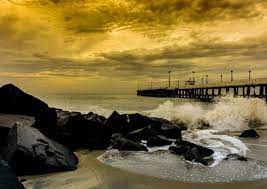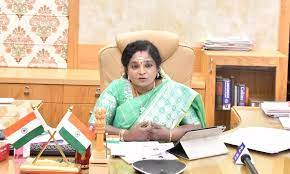Pondicherry
…..There stands Francois Dupleix. Not too far away is Joan of Arc. It’s a trip down France as one crosses symmetrically aligned streets in puducherry.
The Portuguese have been here. So have the Dutch.. The Danes. The English And the French.
By 18th century this tiny fishing village had turned into a grand port city. The French first set foot here in 1670 and left a part of them when their undisturbed rule finished in 1954. Not much has changed since. The history has become punctuated.
The air filled with nostalgia and the present is living up to a heritage that speaks so much. A trip to puducherry is like a journey in time with a vibrant present celebrating its interesting past. “History goes back to the Roman times, but factually started with the arrival of the French in 1963, who founded the town and built it in its present form, during the two and a half century they occupied it.”
“puducherry” is the French interpretation of the original name “Puducheri” meaning “new settlement”. Many pilgrims have shared the town’s hospitality on their way to the temple town of Rameshwaram, thus enriching its culture.
Early Period
The known history of puducherry dates back to the beginning of our era. puducherry also had a flourishing maritime history. Excavations at Arikamedu, about 7 kms to the south of the town, show that Romans came here to trade in the 1st Century AD.
The trade included dyed textiles, pottery and semi-precious stones. The findings are now displayed in the puducherry Museum. Ancient Roman scripts mention one of the trade centres along the Indian coast as Poduca or Poduke, which refers, historians affirm, only to the present puducherry.
Before this period nothing is known with certainty. The "Bahur Plates", issued in the 8th century speak of a Sanskrit University which was here from an earlier period. Legend has it that the sage Agastya established his Ashram here and the place was known as Agastiswaram. An inscription found near the Vedhapuriswara Temple hints at the credibility of this legend.
History continues at the beginning of the fourth century A. D. when the puducherry area is part of the Pallava Kingdom of Kanchipuram. During the next centuries puducherry is occupied by different dynasties of the south: in the tenth century A.D.
The Cholas of Tanjavur took over, only to be replaced by the Pandya Kingdom in the thirteenth century. After a brief invasion by the Muslim rulers of the North, who established the Sultanate of Madurai, the Vijayanagar Empire took control of almost all the South of India and lasted till 1638, when the Sultan of Bijapur began to rule over Gingee.
Foreign contacts
Unlike the Arab merchants, who had been sailing the coasts of India since times immemorable, the impact of European contact had far reaching consequences in terms of establishments and in the end the occupation of the entire Subcontinent.
In 1497 the Portuguese discovered the route to India and began to expand their influence by occupying coastal areas and building harbour towns, which soon extended more than 12.000 miles of coast-line.
The Portuguese established a factory in puducherry at the beginning of the sixteenth century, but were compelled to leave a century later by the
ruler of Gingee, who found them unfriendly. After that the Danes shortly set up an establishment, and likewise the Dutch. The latter set up trading posts in Porto Novo and Cuddalore. The French, who had trading centres in the North, Mahe and Madras were invited to open a trading centre in puducherry by the new ruler of Gingee to compete with the Dutch.
In 1673, February 4th, Bellanger, a French officer, took up residence in the Danish Lodge in puducherry and the French Period of puducherry began.In 1674 Francois Martin, the first Governor, started to build puducherry and transformed it from a small fishing village into a flourishing port-town.
In 1693 the Dutch took over and fortified the town considerably. But four years later Holland and France signed a peace treaty and the French regained puducherry in 1699. In the 18th century the town was laid out on a grid pattern and grew considerably.
Able Governors like Lenoir (1726-1735) and Dumas (1735-1741) and an ambitious Governor Dupleix (1742-1754) expanded the puducherry area and made it a large and rich town. But ambition clashed with the English interests in India and the local kingdoms and a period of skirmishes and political intrigues began. Under the command of Bussy, Dupleix's army successfully controlled the area between Hyderabad and Cape Comorin. But then Robert Clive arrived in India, a dare-devil officer who dashed the hopes of Dupleix to create a French Colonial India. After a defeat and failed peace talks, Dupleix was recalled to France.
 |
In spite of a treaty between the English and French not to interfere in local politics, the intrigues continued. Subsequently France sent Lally Tollendal to regain the French losses and chase the English out of India. After an initial success they razed Fort St. David in Cuddalore to the ground, but stategic mistakes by Lally led to the loss of the Hyderabad region and the siege of puducherry in 1760. In 1761 puducherry was razed to the ground in revenge and lay in ruins for 4 years. The French had lost their hold in South India.
In 1765 the town is returned to France after a peace treaty with England in Europe. Governor Law de
Lauriston set to rebuild the town on the old foundations and after five months 200 European and 2000 Tamil houses had been erected. During the next 50 years puducherry changed hands between France and England with the regularity of their wars and peace treaties.
Only after 1816 the French regained permanent control of puducherry, but the town had lost much of its former glory. Successive Governors improved infrastructure, industry, law and education over the next 138 years. In 1947 the English left India for good, but it lasted till 1954 when the French handed puducherry over to an independent India.
After Independent
On November 1, 1954, the French possessions in India were de facto transferred to the Indian Union and puducherry became a Union Territory. 280 years of French rule had come to an end. But only in 1963 puducherry became officially an integral part of India after the French Parliament in Paris rattified the Treaty with India.
puducherry became a Union Territory, not a separate State. A Union Territory (UT) has its own government but falls directly under the Central Government in New Delhi. Though a UT also has an elected Chief Minister and cabinet members, laws and legislative regulations made in these areas have to get sanction or need to be ratified by the Central Government (Centre).
The Centre is represented by the Lt. Governor, who resides at the Raj Nivas at the Park, the former palace of the French Governor.puducherry still has a large number of Tamil residents with French passports, whose ancestors were in French Governmental service and who chose to remain French at the time of Independence. Apart from the monuments pertaining to the French Period, there is the French Consulate in puducherry and several cultural organisation, and even the Foyer du Soldat for war veterans of the French Army. Of the cultural organisations the French Institute, the Alliance Francais and the Ecole Francais d'Extrème Orient are noteworthy.
About Governor
Tamilisai Soundararajan
His Excellency Lt.Governor of Puducherry
 |
Dr. Tamilisai Soundararajan was born on 2nd June 1961, in Nagercoil, Kanya Kumari District, Tamilnadu. Dr. Tamilisai Soundararajan took charge as Lieutenant Governor of Puducherry on 18th February 2021.
She has a remarkable public & social service background spanning over 20 years. She also has an illustrious political career in last two decades where she has successfully led the state unit of a political party with noteworthy accomplishments.
Dr. Tamilisai Soundararajan started her career as a medical practitioner after completing her M.B.B.S., P.G. in Gynecology (DGO). She has undertaken special training on Ultrasound & Fetal Therapy at Toronto, Canada. She worked as an Assistant Professor (Department of Gynecology at Sri Rama Chandra Medical College – Chennai) for 7 years & resigned in 2003 for full time political engagements.
She nurtures great devotion towards public service and enhancement of living standards of common people with focus on health and education as a prime agenda. She has donned the hat of being a State Head of a political party & steering it with exemplary management skills & pro-people service milieu.
Dr. Tamilisai Soundararajan is a proud recipient of an international award titled “ International Rising Star of the Year – 2018” by multi Ethnic advisory task force, USA under US Congressman Danny. K. Davis for her services to the society especially in the field of Politics, Public and Medical Services.
Dr. Tamilisai Soundararajan is known for her strong advocacy towards uplifting living standards of people through better health and preventive care. She is a great admirer of social & cultural strengths of our country and very considerate towards inclusion of values & humility right at basic education system & upwards.
Dr. Tamilisai Soundararajan happens to be very focused towards development of society and well-being of citizens even at last mile.
Medicine as Profession & Career
| Description |
Details |
| Medical Qualification |
Doctor (MBBS, DGO) |
| Professional Specialization |
Post Graduate in Gynecology |
| Special Training |
Sonology & Fetal Therapy (Canada, Australia & London) |
| Work Experience |
Worked as Asst. Professor (Department of Gynecology at Sri Rama Chandra Medical College – Chennai) for 7 years & resigned in 2003 for full time political engagements |
Political Career
| Description |
Details |
| Student Leader |
Madras Medical College |
| 1999 to 2001 |
South Chennai District Medical Wing Secretary. |
| 2001 to 2004 |
State General Secretary Medical Wing |
| 2004 to 2005 |
Zonal in-charge (3 districts) |
| 2005 to 2007 |
All India Co-convener (Medical Wing or Southern States) & State Spokesperson |
| 2007 to 2010 |
State General Secretary (Tamilnadu BJP parent body) & State Spokesperson |
| 2010 to 2013 |
State Vice President (Tamilnadu BJP parent body) & State Spokesperson |
| 2013 to Aug 2014 |
National Secretary ( All India BJP) & State Spokesperson |
| Aug 2014 till 1st Sep 2019 |
Tamilnadu State President – BJP |
|
Contact Details
| Name: |
Dr. Tamilisai Soundararajan |
| Date of Birth: |
June 2, 1961 |
| Spouse: |
Dr. P. Soundararajan |
| Birth Place: |
Nagercoil, Kanyakumari District, Tamil Nadu |
| Education: |
MBBS |
| Phone: |
Office :+91-413-2334051, Fax :+91-413-2334025 |
About Chief Minister

Shri. N. RANGASAMY
Hon'ble Chief Minister
|
|
Confidential and Cabinet Department
Cooperation
Revenue and Excise
Planning and Finance
Department of Personnel and Administrative Reforms
General Administration
Health and Family Welfare
Hindu Religious Institutions
Wakf Board
Local Administration
Port
Science, Technology and Environment
Town and Country Planning
Town and Country Planning
Other subjects which are not allocated to any other Ministers
|
| Address : |
No. 9, Vinayagar Koil Street,Thilaspet Puducherry-605 009. |
| Phone: |
+91-9600999999 |